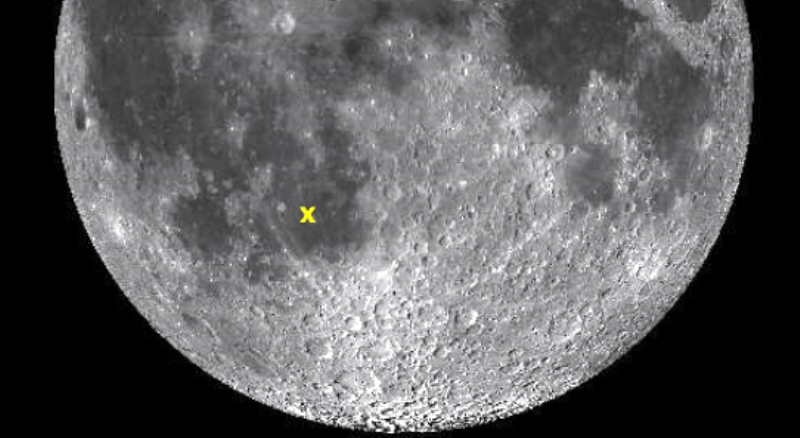First ever confirmed sighting of a Lunar Impact Flash recorded in the British Isles

The Lunar Impact Flash was recorded on the southern hemisphere of the Moon marked with "X", just to the north west of Wolf crater, on 1 January 2017.
20 March 2017
Space scientists at Aberystwyth University have reported what they believe to be the first confirmed sighting of a Lunar Impact Flash to be recorded in the British Isles.
The flash was recorded on the southern hemisphere of the Moon and probably caused by a small meteorite the size of a golf ball hitting the surface.
Lasting less that one tenth of a second, the image was caught on New Year’s Day 2017 on a remotely operated telescope at Aberystwyth University by space scientist Dr Tony Cook.
Dr Cook is a former researcher at the Smithsonian’s National Air and Space Museum in Washington D.C., in the US and has an archive of Lunar Impact Flashes dating back to the early 2000s.
The first confirmed recordings of lunar impact flashes were by amateur astronomers in the US during the Leonid meteor shower of November 1999.
Dr Cook’s latest sighting, the first in the British Isles, has been corroborated by a team of Italian astronomers.
It also forms part of a final year research project undertaken by Astrophysics student Matthew Menzies who is looking at ways of improving how these impacts are recorded and measured.
The findings will be presented at the European Planetary Science Congress which takes place in the Latvian capital Riga later this year.
“Lunar Impact Flashes are notoriously difficult to record” said Dr Cook. “The meteorite would be travelling at anywhere between 10 to 70 km per second as it hit the surface of the Moon. That is the equivalent of travelling from Aberystwyth to Cardiff in just a few seconds, and the resulting impact would be over in a fraction of a second.”
“A similar meteorite hitting the Earth’s atmosphere would produce a beautiful shooting star, but as the Moon has no atmosphere it slams into the surface, causing a crater the size of very large pot hole. Just under 1% of the meteorite’s energy is converted into a flash of light, which we were able to record here in Aberystwyth.”
Scientists estimate the Moon is hit by similar sized meteorites as often as once every 10 to 20 hours.
However the impact flashes are so faint that they are only visible on the night side of the Moon using a telescope. Furthermore, a sighting can only be confirmed if it is seen from more than one location.
“A single image is not enough”, said Dr Cook. “Cosmic rays in the form of radiation from space can produce very brief flashes of light and it can be very difficult to tell the difference between a real impact on the surface of the Moon and a cosmic ray. When you have two images taken at the same time, by different telescopes, looking at the same part of the Moon, you know it is actually on the lunar surface.”
Dr Cook argues that whilst a single impact measurement, on its own, is not significant, studying the statistics of many lunar impact flashes and comparing to the number of craters per square kilometre, can enable scientists to date the Moon’s surface.
“A young area of the moon which has seen very recent volcanic activity, tens or several 100 million years ago, will not have that many craters on it. However, if it is exposed to space for billions of years it’s going to be plastered with craters, so if you count the number of craters, like tree rings, it tells you the relative age of the surface.”
Dr Cook’s research focuses on erosion on the Moon, new craters forming and how dust moves around.
Working with students he is studying the different phases of the explosions in greater detail to understand how much heat is given off, the size of the particles and how far the excavated shrapnel from the impact travels.
He is keen to collaborate with amateur astronomers with telescopes and cameras capable of videoing detail on the night side of the Moon.
This work could prove invaluable should humans decide to colonize the Moon.
“The data we collect will enable us to understand better the nature of these explosions and protect future Moon bases or space craft.
“It is highly likely that anyone standing on the Moon in the vicinity of one of these explosions would be blinded by the flash of light, before being hit by shrapnel travelling at 1-2 km per second. Space suits would be peppered and punctured by it, and this would be the effect even perhaps a few hundred metres away.”
Possible sightings of Lunar Impact Flashes have been recorded over the centuries. As early as 1178 monks in Canterbury noticed a plume of light on the edge of the Moon, the British amateur astronomer F.H. Thornton saw a brilliant flash of light inside the crater Plato in 1948, and in 1953 American amateur astronomer Leon Stuart photographed a long duration flash near the lunar crater Pallas.



